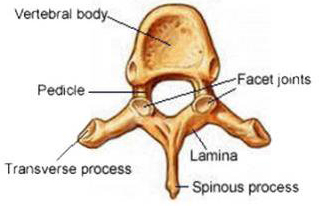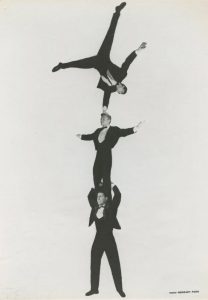Lower Back Pain Is No Circus
Lower back pain can become crippling. Not only does it affect work and relationships, it is frustrating and demoralizing when the cause cannot be readily identified. The World Health Organization says, “Though several risk factors have been identified (including occupational posture, depressive moods, obesity, body height and age), the causes of the onset of low back pain remain obscure and diagnosis difficult to make.”i Still worse, the search for a cure can take months, often involving painful procedures.
Facet Joints
 One cause of lower back pain is deterioration of small spinal connectors called facet joints. The spine is a stack of backbones (spinal column) called vertebrae. Each vertebra has points of contact with the one above and below. Two of these points on each backbone are the facet joints, small bony projections located close to the tunnel through the vertebrae that contains the spinal cord. This imageii is a view from the top of a single vertebra. You can see the central opening for the spinal cord tunnel, and the two facet joints on both sides of it.
One cause of lower back pain is deterioration of small spinal connectors called facet joints. The spine is a stack of backbones (spinal column) called vertebrae. Each vertebra has points of contact with the one above and below. Two of these points on each backbone are the facet joints, small bony projections located close to the tunnel through the vertebrae that contains the spinal cord. This imageii is a view from the top of a single vertebra. You can see the central opening for the spinal cord tunnel, and the two facet joints on both sides of it.
The spinal cord itself is the main trunk line for nerves from the brain, which then branch out through openings between vertebrae to all parts of the body. These nerves carry messages in both directions: from the brain to the body and from the body to the brain. For example, stubbing your toe generates pain signals from your toe to your brain, causing you to feel like someone just hit your toe with a hammer.
The facet joints play several important roles. Since the spine is load-bearing, those small points of contact help distribute weight down the length of the spine. The spine is also flexible to facilitate posture, movement and action, so the facet joints stabilize it as it bends and extends. To prevent the spine from bending or rotating too far in any direction, the joints act as brake pads. Nature provides the equipment to perform these tasks. Each joint has a pad of cartilage and a capsule of what is called synovial fluid. When movement or pressure from carrying a heavy load compresses a synovial joint, the squeezing action on the cartilage pad causes release of synovial fluid. Thus, the cartilage acts like a flexible cushion while the synovial fluid acts like a lubricant. This way, space is preserved where the branches of nerves extend away from the spinal cord. Also, the cartilage protects vertebra from painful, abrasive bone-on-bone friction that would become much more destructive of the spinal column.
Facet Joint Acrobatics
When you were a child, you might have gone to a circus or seen circus acts on TV. Acrobats were always popular. They included daring trapeze artists, athletic tumblers, and gravity-defying human sculptures such as pyramids.
 This vintage photoiii shows three acrobats stacked on top of each other. Notice the points of contact: the man on the bottom is connected to the man in the middle where hands meet legs and shoulders meet feet; the man in the middle is connected to the man on top where head meets hand. If any point of contact weakens, the living sculpture collapses. The facet joints have similar dynamics. If the cartilage wears thin and the synovial capsule is damaged, the top vertebra “collapses” closer to the bottom vertebra. In turn, this pinches the nerves that exit the spinal cord between them, resulting in lower back pain that ranges from distracting to debilitating. Depending on which nerves are pinched, the pain can also shoot down the legs. All together, this leads to physical, emotional, mental, and social compromises that reduce quality of life. In short, facet joint pain in the lower back is no circus.
This vintage photoiii shows three acrobats stacked on top of each other. Notice the points of contact: the man on the bottom is connected to the man in the middle where hands meet legs and shoulders meet feet; the man in the middle is connected to the man on top where head meets hand. If any point of contact weakens, the living sculpture collapses. The facet joints have similar dynamics. If the cartilage wears thin and the synovial capsule is damaged, the top vertebra “collapses” closer to the bottom vertebra. In turn, this pinches the nerves that exit the spinal cord between them, resulting in lower back pain that ranges from distracting to debilitating. Depending on which nerves are pinched, the pain can also shoot down the legs. All together, this leads to physical, emotional, mental, and social compromises that reduce quality of life. In short, facet joint pain in the lower back is no circus.
Stopping Facet Joint Pain at the Source
So far, no one has come up with a successful way to restore or rebuild facet joints once they deteriorate. When the damage – called facet joint osteoarthritis – has occurred, treatments range from anti-inflammatory drugs, pain killers, physical therapy, etc. When those aren’t enough, there are repeatable injections or invasive longer term ablation procedures into the compressed nerves to numb or deaden them. These last approaches can themselves cause pain, and relief may not occur immediately.
The Sperling Medical Group offers an alternative solution. It is a noninvasive, durable treatment called MRI-guided Focused Ultrasound, or MRgFUS. By aiming beams of ultrasound through the skin to target heat on the facet joints, this painless outpatient procedure deadens the nerves that send pain messages to the brain, without impacting normal movement and function. Pain relief is immediate.
Don’t let lower back pain from facet joint arthritis turn your life into a three-ring circus of pain. For more information contact the Sperling Medical Group.
ihttp://www.who.int/medicines/areas/priority_medicines/Ch6_24LBP.pdf
iiImage source ProProfs Quiz Maker, https://www.proprofs.com/quiz-school/story.php?title=vertebral-column_1
iiiImage source: Etsy, https://www.etsy.com/listing/504458126/circus-performers-balancing-act-acrobats
- CATEGORY:
- Facet Pain


